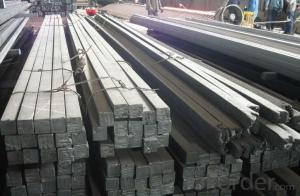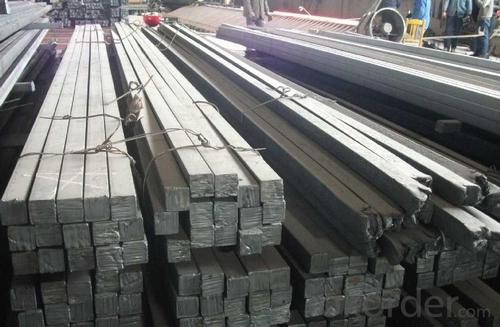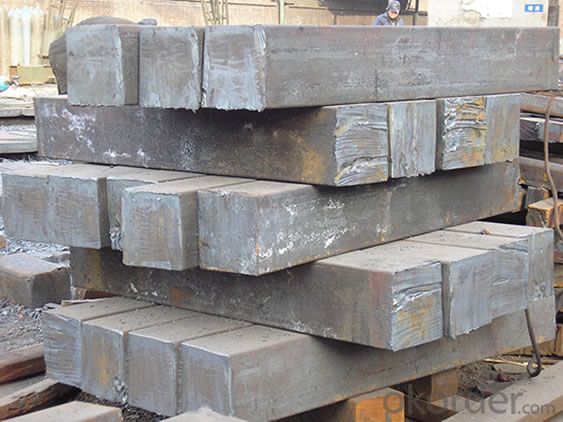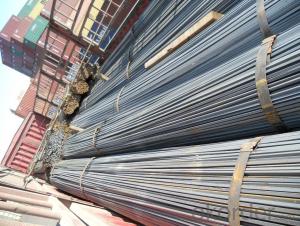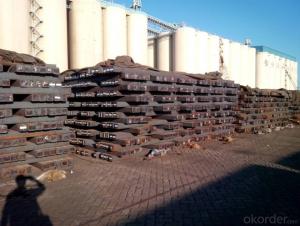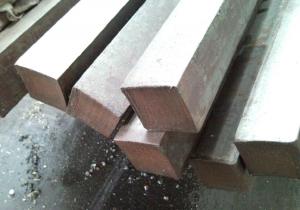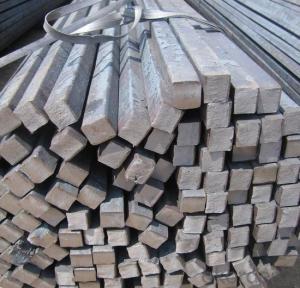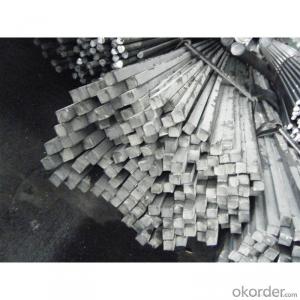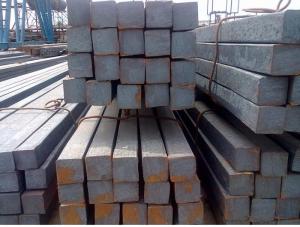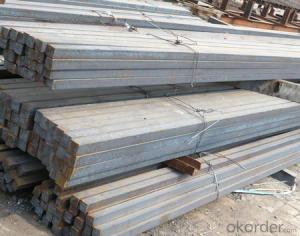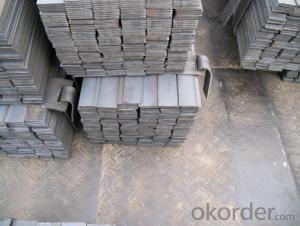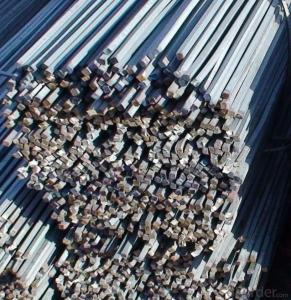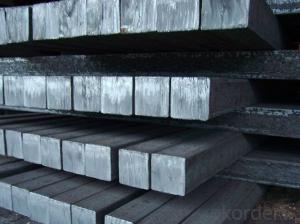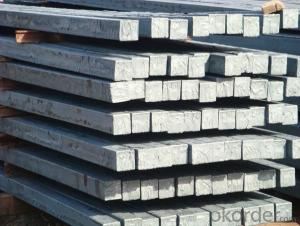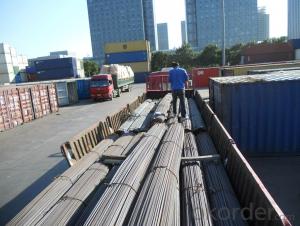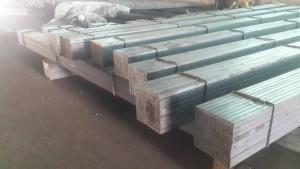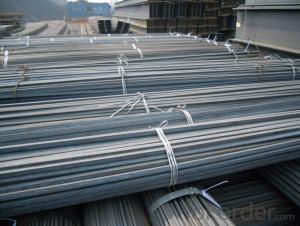High Quality GB Standard Steel Square Bar 26mm-30mm
- Loading Port:
- Tianjin
- Payment Terms:
- TT OR LC
- Min Order Qty:
- 25 m.t
- Supply Capability:
- 10000 m.t/month
OKorder Service Pledge
OKorder Financial Service
You Might Also Like
Product Description:
We offer Square Steel Bar with grade Q195 / Q235
Specifications of Square Steel Bar:
-Standard: GB,
-Grade: Q195/Q235 or equivalent.
Chemical Composition:
-Chemical Composition. Q195
Standard | Grade | Element (%) | ||||
GB | Q195 | C | Mn | S | P | Si |
0.06~0.12 | 0.25~0.50 | ≤0.050 | ≤0.045 | ≤0.30 | ||
-Chemical Composition. Q235
Standard | Grade | Element (%) | ||||
GB | Q235B | C | Mn | S | P | Si |
0.12~0.20 | 0.30~0.70 | ≤0.045 | ≤0.045 | ≤0.30 | ||
Measures and Tolerances of Square Steel Bar:
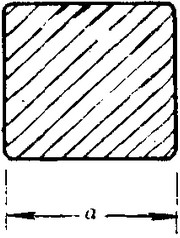
(The section of Square Steel Bar)
-The length of a side and the theoretical weight of Square Steel.
Length of a side(a, mm) | Theoretical weight(kg/m) | Length of a side(a, mm) | Theoretical weight(kg/m) |
6 | 0.283 | 32 | 8.04 |
7 | 0.385 | *33 | 8.55 |
8 | 0.502 | 34 | 9.07 |
9 | 0.636 | *35 | 9.62 |
10 | 0.785 | 36 | 10.17 |
11 | 0.950 | 38 | 11.24 |
12 | 1.13 | 40 | 12.56 |
13 | 1.33 | 42 | 13.85 |
14 | 1.54 | 45 | 15.90 |
15 | 1.77 | 48 | 18.09 |
16 | 2.01 | 50 | 19.63 |
17 | 2.27 | 53 | 22.05 |
18 | 2.54 | *55 | 23.6 |
19 | 2.82 | 56 | 24.61 |
20 | 3.14 | *58 | 26.4 |
21 | 3.46 | 60 | 28.26 |
22 | 3.80 | 63 | 31.16 |
*23 | 4.15 | *65 | 33.17 |
24 | 4.52 | *68 | 36.3 |
25 | 4.91 | 79 | 38.49 |
26 | 5.30 | 75 | 44.16 |
*27 | 5.72 | 80 | 50.24 |
28 | 6.15 | 85 | 56.72 |
*29 | 6.60 | 90 | 63.59 |
30 | 7.06 | 95 | 70.85 |
*31 | 7.54 | 100 | 78.50 |
Notes:
1, The theoretical weights in the list, base on the density of 7.85 g/cm3.
2, The numbers with *mean that they are not regulars or we don’t offer them.
-The allowed tolerance of Square Steel:
Length of a side(mm) | Allowed Tolerance | ||
Group1 | Group2 | Group3 | |
5.5~7 | ±0.20 | ±0.30 | ±0.40 |
7~20 | ±0.25 | ±0.35 | ±0.40 |
20~30 | ±0.30 | ±0.40 | ±0.50 |
30~50 | ±0.40 | ±0.50 | ±0.60 |
60~80 | ±0.60 | ±0.70 | ±0.80 |
80~110 | ±0.90 | ±1.0 | ±1.1 |
110~150 | ±1.2 | ±1.3 | ±1.1 |
150~190 | ―― | ―― | ±2.0 |
190~250 | ―― | ―― | ±2.5 |
Usage/Applications of Steel Square Bar:
-The Square Steel is normally used as structure steel.
-Row material for other structure steel like steel angles, channels, I-beams, H-beams, etc…
Packaging & Delivery of Steel Square Bar:
-Packing Detail: The products can be packed in bundles by steel wires.
-Marks:
1, Tag marks: the tag marks will be tied up to each bundle of the products. The information is usually including supplier’s logo and name, product name, made in China, products’ specifications, the painted color and other information requested by customers.
2, Color marks: we will paint both ends of the bundles of these products to make sure that they are more evident. It’s will be more convenient for the customers to distinguish them at the destination port.
-Delivery Detail: 30~45 working days after receive buyer’s T.T. or L/C.
Transportation:
-The products can be delivered by bulk vessel or by container. As for container, products with the length of 6m will be loaded in 20’ container, with 9m or 12m, in 40’ container.
-The maximum quantity of loading of container is 25 tons.
-The products usually are transported to the nearest port from the production place.
- Q: Can a steel square be used for checking the squareness of a door opening?
- A door opening's squareness can be assessed using a steel square. This versatile tool, also known as a framing square or carpenter's square, is typically crafted from steel and features markings for angle measurement and right angle verification. With its 90-degree angle, the steel square proves useful for checking the squareness of various objects, including door openings. To examine the squareness of a door opening using a steel square, one must position the square against the door jamb or frame's edges, ensuring a flush and flat fit on both sides. By observing the alignment of the square's edge against the door jamb, one can determine if the opening's corners form perfect 90-degree angles or deviate from a square shape. If the steel square fits flawlessly against both sides of the door jamb, with no gaps or overlaps, then the door opening is square. However, the presence of a gap or improper alignment with the edges indicates that the opening is not square, necessitating adjustments to ensure the door's proper installation. In summary, a steel square serves as an effective tool for evaluating the squareness of a door opening. Its accurate measurement and assessment capabilities contribute to ensuring the proper fit and functioning of the door post-installation.
- Q: What is the purpose of the tongue and groove on a steel square?
- The tongue and groove found on a steel square serve a critical purpose in carpentry and related fields. This design element enables precise and accurate measurements and marking. By ensuring perfect alignment and squareness, the tongue and groove contribute to stability, preventing any unwanted movement or slippage when the square is used against a flat surface or edge. Consequently, the measurements and markings made using the steel square are consistently reliable, making it an indispensable tool for tasks like marking and cutting angles, checking for squareness, or laying out patterns. Furthermore, the tongue and groove design also offers the convenience of easy storage and transportation. The steel square can be effortlessly folded and locked together, reducing the risk of damage or misplacement. Overall, the tongue and groove on a steel square play a vital role in enhancing precision, accuracy, and efficiency in various woodworking and metalworking applications.
- Q: Can a steel square be used for creating perpendicular lines?
- Yes, a steel square can be used for creating perpendicular lines.
- Q: How do you use a steel square to find the length of a rafter?
- To use a steel square to find the length of a rafter, you can follow these steps: 1. Begin by placing the steel square on the end of the rafter board, with the shorter arm (tongue) resting against the edge of the board. 2. Align the longer arm (body) of the square with the edge of the rafter board, ensuring it runs parallel to the board's length. 3. Once the square is properly positioned, make a mark on the rafter board where the longer arm of the square intersects the board. 4. Next, move the square along the length of the rafter, ensuring the shorter arm remains against the edge of the board. 5. Continue marking the rafter board at each intersection point where the longer arm of the square crosses the board. 6. Once you have marked multiple points along the length of the rafter, connect the marks with a straight line. 7. Finally, measure the length of the straight line you drew, which represents the length of the rafter. Using a steel square in this manner helps ensure accurate measurements and allows you to find the length of a rafter quickly and easily.
- Q: Can a steel square be used for checking the squareness of a router table top?
- Yes, a steel square can be used for checking the squareness of a router table top.
- Q: How do you use a steel square to measure and mark 112.5-degree angles?
- To measure and mark a 112.5-degree angle using a steel square, follow these steps: 1. Place the steel square on the surface or material where you want to measure the angle. 2. Align one edge of the square with the reference line or edge from where you want to start measuring the angle. 3. Rotate the square until the opposite edge aligns with the desired angle measurement, in this case, 112.5 degrees. 4. Hold the square firmly in place, ensuring it doesn't move. 5. Using a pencil or marker, mark the angle measurement where the square intersects the material. 6. Remove the square and connect the marked point with the reference line or edge to form a 112.5-degree angle. Remember to use caution and accuracy while measuring and marking the angle to achieve the desired result.
- Q: Can a steel square be used for gazebo post layout and installation?
- Yes, a steel square can be used for gazebo post layout and installation. A steel square, also known as a framing square or a carpenter's square, is a versatile tool commonly used in construction and woodworking. It consists of a long blade and a shorter tongue that meet at a 90-degree angle, allowing for accurate measurements and layout. When it comes to gazebo post layout and installation, a steel square can be a valuable tool. It can assist in determining the correct angles and measurements for positioning the posts, ensuring that they are level and aligned properly. To use a steel square for gazebo post layout, you can use it to mark out the corners and angles where the posts should be placed. By aligning the blade or the tongue of the square with the edges of the gazebo base or the desired position of the posts, you can ensure accurate measurements and angles. During installation, a steel square can also be handy for checking that the posts are plumb and level. By placing the square against the sides of the posts, you can verify if they are perfectly vertical or if adjustments need to be made. In summary, a steel square can certainly be used for gazebo post layout and installation. Its versatility and accuracy make it a useful tool for ensuring that the posts are positioned correctly and are level.
- Q: How do you use a steel square to create compound miter cuts?
- In order to create compound miter cuts using a steel square, a series of steps must be followed. To begin, the desired angle of the compound miter cut must be determined. This can be accomplished by either referring to project plans or using a protractor to measure the angle. Following this, position the steel square onto the workpiece at the chosen angle, ensuring that the long side of the square aligns with the edge of the workpiece. Once the square is properly placed, utilize a pencil or marker to mark the cut line along the edge of the square. This marking will indicate where the cut needs to be made. Next, the bevel angle of the miter saw or table saw must be adjusted to match the angle of the compound miter cut. This adjustment is typically made by loosening a bevel lock or manipulating a bevel gauge on the saw. After the bevel angle has been adjusted, align the marked cut line on the workpiece with the saw blade. It is important to double-check that the bevel angle matches the angle on the steel square. Lastly, proceed to make the compound miter cut with caution. Slowly push the workpiece through the saw, ensuring a clean and precise cut. Always prioritize safety when operating power tools and handling sharp blades. Wear appropriate protective gear and adhere to the manufacturer's instructions for your specific saw model.
- Q: How do you use a steel square for marking parallel lines?
- To use a steel square for marking parallel lines, first ensure that the square is positioned firmly against the edge of the material you want to mark. Then, draw a line along one edge of the square using a pencil or a marking tool. Next, without moving the square, align the edge of the square with the line you just drew and mark another line parallel to the first one. Repeat this process as needed to create multiple parallel lines.
- Q: How do you use a steel square to measure and mark parallel lines?
- To use a steel square to measure and mark parallel lines, follow these steps: 1. Place the steel square on the edge of the material you want to mark the lines on. Make sure the long side of the square is aligned with the edge of the material. 2. Hold the square firmly in place, ensuring it doesn't move or shift during the process. 3. Take a pencil or a marking tool and slide it along the shorter side of the square, marking a line on the material parallel to the edge. 4. Repeat the process at different points along the edge, marking multiple parallel lines as needed. By keeping the steel square aligned with the edge and sliding the marking tool along its shorter side, you can ensure that the lines you mark will be parallel to the edge of the material. This method is useful in various applications, such as carpentry, woodworking, metalworking, and other trades where precise and parallel lines are required.
Send your message to us
High Quality GB Standard Steel Square Bar 26mm-30mm
- Loading Port:
- Tianjin
- Payment Terms:
- TT OR LC
- Min Order Qty:
- 25 m.t
- Supply Capability:
- 10000 m.t/month
OKorder Service Pledge
OKorder Financial Service
Similar products
Hot products
Hot Searches
Related keywords
